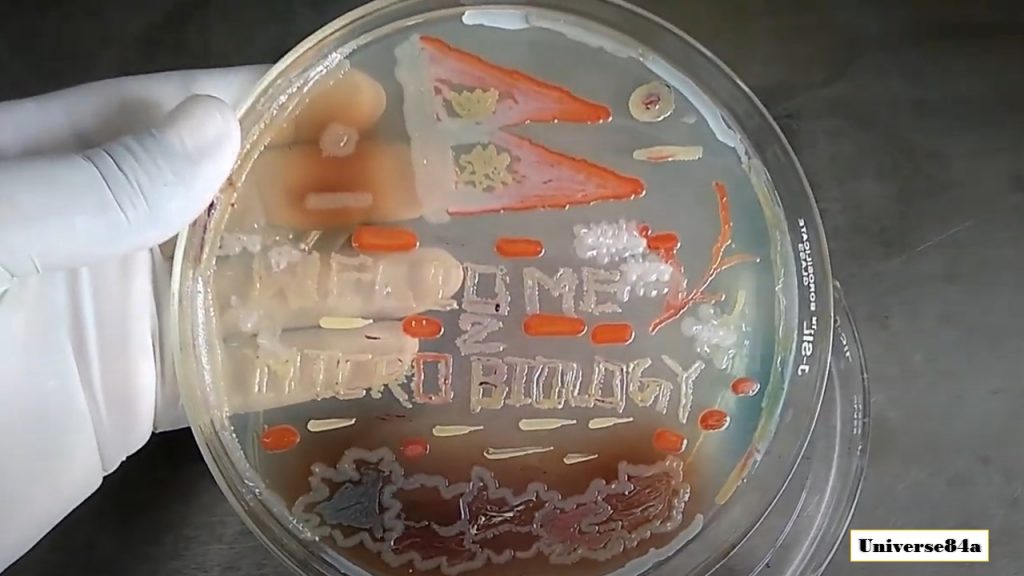Microbial Art: Introduction, Requirements, Making Procedure, Uses and Keynotes

Introduction of Microbial Art
Agar art or microbial art or germ art is the same thing in which artwork is created by culturing microorganisms in certain patterns. The microbes used can be bacteria, yeast fungi, or protists (less commonly). The microbes can be chosen for their natural colors. Organisms most commonly used and available are Staphylococcus aureus, Pseudomonas aeruginosa , Serratia marcescens as shown above picture. Painting with bacteria isn’t entirely new because Sir Alexander Fleming, the scientist responsible for discovering penicillin in the 1920s, began making “germ paintings” of bacteria during his career as a microbiologist. Similarly, Roger Tsien (biochemist) won the 2008 Nobel prize in chemistry for his contributions to the knowledge of green fluorescent protein (GFP), and using this GFP, Nathan Shaner (researcher) made a 2006 microbial artwork of a San Diego beach scene.
Requirements for Agar Art with Living Microbes
- Agar plate
- Microorganisms ( microbes):
- Bacillus subtilis (cream to brown),
- Chromobacterium violaceum (violet)
- Escherichia coli (colorless)
- Micrococcus luteus (yellow)
- Micrococcus roseus (pink)
- Proteus mirabilis
- Pseudomonas aeruginosa strains having variuous pigments i.e. pyocyanin, pyoverdin, prorubrin and pyomelanin
- Serratia marcescens (pink or orange)
- Staphylococcus aureus (yellow)
- Vibrio fischeri (bioluminescent)
- Yeast species – which are fungi – used include Saccharomyces cerevisiae (yellow-white)
- Aspergillus flavus (yellow-green spores)
- Aspergillus ochraceus (yellow)
- Aureobasidium pullulans (black)
- Candida albicans (whitish buff)
- Candida species (whitish)
- Cladosporium herbarum (brown to black)
- Cladosporium resinae
- Epicoccum nigrum (yellow, orange, red, brown, and black),
- Fusarium species
- Rhodotorula species and Scopulariopsis brevicaulis
- Protist species used include Euglena gracilis (photosynthetic, green) and
- Physarum polycephalum (yellow-green)
- Inoculating loop
- Bunsen burner
- Incubator
Procedure of Microbial Art
- Before starting agar art with living microbes, keep all the following points in your mind-
- Start planning early
- Keep an eye out for colorful bacteria
- Paint with a steady hand
- Be ready to experiment
- keep experimenting
- Don’t give up
- Allow the plates to warm at room temperature, and the agar surface to dry before inoculating.
- Fill the portrait with colorful organisms.
- Incubate the agar plate.
- Observe the agar plate.
Uses of Microbial Art
- You can use microbial art in the ‘ASM Agar Art Contest’.
- You can also put agar art in your gallery or your laboratory to build your self-confidence as a creator.
Keynotes on Microbial Art
- You can uses microbes as your interest.
- Try to use normally non-pathogenic organisms.
- Follow usual guidelines for all contaminated waste.
- Take safety precautions during experiments.
- If you are wording in the microbiology laboratory and thinking about agar art, store the colorful organisms.
- For more details, watch the videos as shown below-
#Agar art with living microbes preparation tips and its importance-
Further Readings on Microbial Art
- https://health.sunnybrook.ca/how-it-works/agar-
- art/https://en.wikipedia.org/wiki/Microbial_art
- https://asm.org/Events/ASM-Agar-Art-Contest/Previous-Winners
- https://www.scienceinschool.org/content/painting-petri-dish
- https://www.goldbio.com/articles/article/unconventional-uses-of-microbes-how-bacteria-becomes-art
